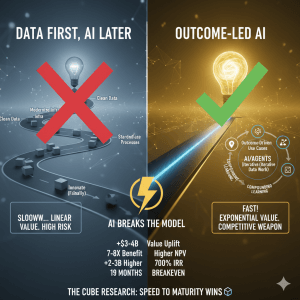As modern IT and application environments evolve, the need for innovative solutions to manage the complexity and demands of distributed systems has become increasingly apparent. I recently, spoke with Balaji Prabhakar, co-founder of Clockwork.io, about how his company’s software is optimizing the performance of time-sensitive applications across highly distributed networks.
The Growing Complexity of Distributed Environments
We discussed the changing landscape of IT infrastructure that has resulted in applications being no longer confined to a single data center or even a few regional data centers. Instead, they are spread across multiple private data centers, public clouds, and edge locations, with users accessing them from anywhere in the world. This decentralization presents significant challenges, particularly in maintaining the performance and reliability of applications across such a dispersed network.
Prabhakar confirmed that this trend towards distributed systems is something Clockwork.io has been keenly aware of. He explained that since the advent of Web 2.0, with the rise of cloud computing and smartphones, applications have increasingly relied on distributed architectures. This shift has driven the need for a new approach to managing and optimizing these networks, particularly as they continue to scale.
The Problem with Clockless Networks
For the past 50 years, the development of networked systems has been guided by a “clockless” paradigm. This approach, while enabling significant scalability, has come at the cost of performance. As networks have grown faster and more complex, the lack of accurate time synchronization across distributed systems has led to inefficiencies and performance bottlenecks. This is where Clockwork.io steps in.
Clockwork.io’s technology is rooted in the need for accurate timing to enable applications to perform at their best. The company’s solution, which began as research at Stanford University, aims to synchronize clocks across distributed systems without relying on network infrastructure. This approach allows for more precise measurements of latency and congestion, leading to better performance and higher network utilization.
Revolutionizing Network Performance with Clock Sync
The core of Clockwork.io’s innovation lies in its ability to synchronize clocks across distributed nodes, enabling applications to better understand and manage network latencies. By doing so, the software can reduce congestion, eliminate packet drops, and optimize the overall performance of the network.
Prabhakar illustrated the importance of clock synchronization with examples from the financial trading and gaming industries, where even the slightest delay can have significant consequences. In high-frequency trading, for instance, the order in which trades are processed can impact fairness and profitability. Similarly, in multiplayer gaming, ensuring that actions are registered in the correct order is crucial for a fair and enjoyable experience.
In both cases, Clockwork.io’s technology ensures that clocks are synchronized across the network, allowing for more accurate measurements of packet transmission times and, consequently, better control over network performance.
The Origins of Clockwork.io’s Technology
When asked about the origins of Clockwork.io’s technology, Prabhakar shared that the initial idea stemmed from the concept of network tomography, which involves reconstructing internal network conditions based on observations from the edge. The team at Stanford developed an algorithm to achieve this, but they quickly realized that the accuracy of their measurements depended on synchronized clocks. This realization led them to focus on clock synchronization as a key component of their solution.
Real-World Applications and Benefits
Clockwork.io’s technology is already being used by several organizations, particularly in the financial sector. Prabhakar mentioned NASDAQ and other market participants as examples of customers who have benefited from the software’s ability to enhance fairness and efficiency in trading. By ensuring that trades are processed in the correct order and with minimal delay, Clockwork.io helps these organizations maintain a competitive edge in a fast-paced industry.
Beyond financial services, Prabhakar noted that the technology has broader applications in any environment where latency and consistency are critical. For instance, distributed databases can achieve stronger consistency guarantees with synchronized clocks, improving the accuracy and reliability of data across different nodes.
Performance Gains
Clockwork.io’s solution requires the installation of a software agent on the nodes that need synchronization. Once installed, the software synchronizes the clocks and begins optimizing network traffic to reduce latency and packet drops. The result is a significant improvement in network performance, with organizations able to achieve better throughput and efficiency without the need for costly over-provisioning of bandwidth.
Prabhakar highlighted that this approach can lead to substantial cost savings, as companies can achieve the same performance with fewer resources. For example, a task that might previously have required 100 virtual machines could potentially be handled by just 70, thanks to the efficiencies introduced by Clockwork.io.
Regulatory Implications and Future Prospects
In addition to the performance benefits, Clockwork.io’s technology also offers advantages from a regulatory perspective. In the financial sector, regulations such as MiFID II in the European Union require trading firms to capture market data accurately. Clock synchronization is essential to meet these requirements, making Clockwork.io’s solution both a business advantage and regulatory necessity.
The need for accurate clock synchronization and efficient network management will only grow as more organizations adopt distributed environments. By enabling companies to manage their networks more effectively, Clockwork.io is helping them navigate the complexities of modern IT infrastructure, remain compliant, and stay ahead in an increasingly competitive landscape.
Optimizing the performance of time-sensitive applications
In today’s distributed and hybrid cloud environments, managing and optimizing the performance of time-sensitive applications is more critical than ever. Clockwork.io’s innovative approach to clock synchronization offers a powerful solution to latency, congestion, and fairness challenges in distributed systems. As more organizations recognize the importance of network performance in achieving their business goals, technologies like those developed by Clockwork.io will play a vital role in shaping the future of IT infrastructure.
For more information about this solution please visit the clockwork.io website
See more of my coverage here:
Gen AI and IT Infrastructure: Exploring the Impact on the Network (thecuberesearch.com)



